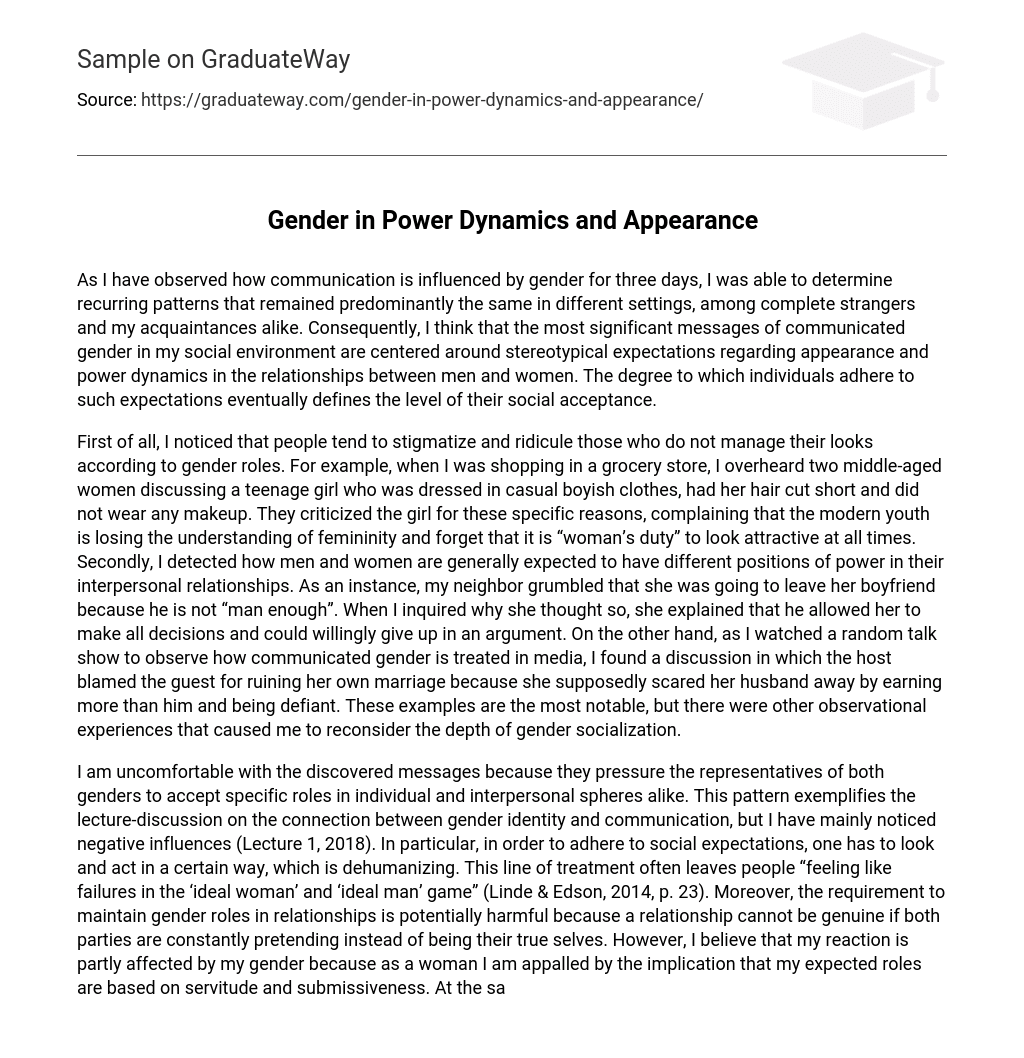As I have observed how communication is influenced by gender for three days, I was able to determine recurring patterns that remained predominantly the same in different settings, among complete strangers and my acquaintances alike. Consequently, I think that the most significant messages of communicated gender in my social environment are centered around stereotypical expectations regarding appearance and power dynamics in the relationships between men and women. The degree to which individuals adhere to such expectations eventually defines the level of their social acceptance.
First of all, I noticed that people tend to stigmatize and ridicule those who do not manage their looks according to gender roles. For example, when I was shopping in a grocery store, I overheard two middle-aged women discussing a teenage girl who was dressed in casual boyish clothes, had her hair cut short and did not wear any makeup. They criticized the girl for these specific reasons, complaining that the modern youth is losing the understanding of femininity and forget that it is “woman’s duty” to look attractive at all times. Secondly, I detected how men and women are generally expected to have different positions of power in their interpersonal relationships. As an instance, my neighbor grumbled that she was going to leave her boyfriend because he is not “man enough”. When I inquired why she thought so, she explained that he allowed her to make all decisions and could willingly give up in an argument. On the other hand, as I watched a random talk show to observe how communicated gender is treated in media, I found a discussion in which the host blamed the guest for ruining her own marriage because she supposedly scared her husband away by earning more than him and being defiant. These examples are the most notable, but there were other observational experiences that caused me to reconsider the depth of gender socialization.
I am uncomfortable with the discovered messages because they pressure the representatives of both genders to accept specific roles in individual and interpersonal spheres alike. This pattern exemplifies the lecture-discussion on the connection between gender identity and communication, but I have mainly noticed negative influences (Lecture 1, 2018). In particular, in order to adhere to social expectations, one has to look and act in a certain way, which is dehumanizing. This line of treatment often leaves people “feeling like failures in the ‘ideal woman’ and ‘ideal man’ game” (Linde & Edson, 2014, p. 23). Moreover, the requirement to maintain gender roles in relationships is potentially harmful because a relationship cannot be genuine if both parties are constantly pretending instead of being their true selves. However, I believe that my reaction is partly affected by my gender because as a woman I am appalled by the implication that my expected roles are based on servitude and submissiveness. At the same time, my gender could also be the reason why I paid more attention to the situations that concerned women, which I realized only after reviewing my records.
Due to this unintentional subjectivity, I asked my male friend to evaluate my observations from his point of view. In response, he noted that I did not address the problem of appearance expectations for men, although he agreed that it is likely worse for women, whose personal value is usually measured by physical attractiveness. Also, he made a thought-provoking addition to the message of power dynamics in relationships. Specifically, he explained how men are not allowed to be emotionally vulnerable, which prevents them from expressing their feelings to their loved ones. This response serves as the proof that “systems of patriarchy have costs for men, not just women” (Linde & Edson, 2014, p. 23). After considering this, I decided to analyze my experience through the lens of sociological concepts.
Two specific concepts that clarify and expand my observation exercise are the social construction of gender and gender socialization. The idea that gender is socially constructed explains the existence of “seemingly unconscious performances” regarding numerous gender roles, taboos, and expectations, which establish the gap between men and women by dictating appropriate behavior and life choices (Linde & Edson, 2014, p. 20). The concept of gender socialization, as explained by Julia Wood, Angela Tretheway, and Marsha Houston, is closely connected to this issue because it initially creates such constructs by teaching the representatives of both genders though communication, as well as through social approval or disapproval (Lecture 1, 2018). Thus, when these two concepts are considered together, they become immensely relevant regarding my observations. In particular, when I had an opportunity to ask people why they assigned certain roles to either men or women, they could only state that this how it should be. No one could provide me a clear explanation as to why men cannot let women win in an argument or why women are supposed to be beautiful in order to be taken seriously. These and other similar notions resulted from socialization, leading to the existence of social constructs.
All in all, my observation emphasized the prevalence of stereotypical roles in gender communication, thus illustrating the concepts of gender socialization and the social construction of gender. Since I admit that my records are more female-focused because of my gender, I value the contribution of my male friend in the form of his response that men also suffer from appearance-related expectations and they are not allowed to express their feelings freely. Overall, I am uncomfortable with the fact that even the seemingly progressive modern society still permits stereotypes to shape communication and relationships. Therefore, I hope that a deeper analytic understanding of this problem will provide a way to liberate the notion of gender from social expectations.
References
- Alberts, J., Nakayama, T., & Martin, J. (2010). Human communication in society (2nd ed.). Boston: Pearson.
- Lecture 1. Module 1: Introducing Gendered Communication. (2018). Lecture, Arizona State University.
- Linde, J. A., & Edson, B. A. (2014). The process of gender (3rd ed.). Dubuque, IA: Kendall Hunt 3Publishing Company.





